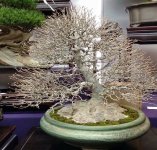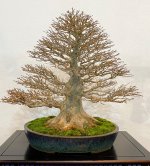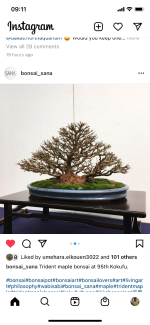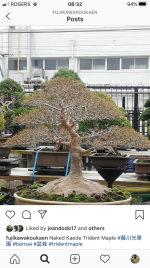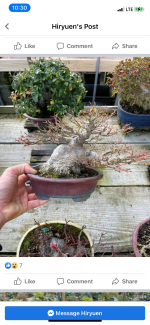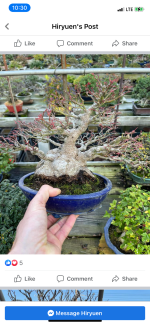You are using an out of date browser. It may not display this or other websites correctly.
You should upgrade or use an alternative browser.
You should upgrade or use an alternative browser.
Help me choose and why you would pick it
- Thread starter baldone
- Start date
JudyB
Queen of the Nuts
Need to see the lower trunks and root structure to give you realistic guidance. This is probably what you’d keep out of any of these moving forward, as none have taper or movement.
River's Edge
Imperial Masterpiece
bwaynef
Masterpiece
It depends what your end goal is. Think of these as starter material. You'll need to do extensive rootwork on all of them (its not hard to do, but its better to do it early) and likely will need to chop all of them. Where you chop is dependent on your goals. Are these worth however much they cost - 4 or more years of your life to get that thickness for the first section of trunk?
This is the age-old question of what to do with field grown trees. These are likely "reasonably" priced and will give you a head start on girth of lower trunk. As others have pointed out, the roots on these will likely need substantial work for that nice radial nebari and decisions will need to be made as far as taper and movement are concerned, as these trees don't have much of either. There are really no right answers here and everyone will have a different approach (and some would pass on these altogether).
Desert O'Piñon
Chumono
Great place to start! The abundance of knowledge and willingness to help you advance in your ability is why what I signed up for.Thought I would ask some of you that have been doing it for a while.
One day, when we are veterans, it will be our responsibility to carry on the wisdom and generosity to the next generation.
Darth Masiah
Omono
go for the best nebari structure first.
Canada Bonsai
Chumono
- Messages
- 543
- Reaction score
- 1,774
Here are some pictures of trident maples
In general, there is movement/bend and or a branch within the first 2-4" from the soil line, which your options don't really have. If the roots are very interesting, I might consider the 3rd image that you posted because it has many back buds that you can potentially cut back to and/or use as sacrifice branches to develop some flare and contribute to overall nebari development. I would even consider moving towards a shohin design out of this material -- I attached 2 pictures of japanese maple shohin for inspiration, but you can do the same with trident. These were thick trunks that were chopped back and developed as chunky-based shohin. That said, your 4 options have very large leaves for a trident maple and might not be ideal for shohin or even larger designs for that matter. Based on the roots of the 4th image, I suspect these will all have very bad roots to work with and you would literally be better off starting with a cutting. Tridents grow quickly, and especially where you are in Georgia you will catch up to material like this and surpass it in just a few years.
In general, there is movement/bend and or a branch within the first 2-4" from the soil line, which your options don't really have. If the roots are very interesting, I might consider the 3rd image that you posted because it has many back buds that you can potentially cut back to and/or use as sacrifice branches to develop some flare and contribute to overall nebari development. I would even consider moving towards a shohin design out of this material -- I attached 2 pictures of japanese maple shohin for inspiration, but you can do the same with trident. These were thick trunks that were chopped back and developed as chunky-based shohin. That said, your 4 options have very large leaves for a trident maple and might not be ideal for shohin or even larger designs for that matter. Based on the roots of the 4th image, I suspect these will all have very bad roots to work with and you would literally be better off starting with a cutting. Tridents grow quickly, and especially where you are in Georgia you will catch up to material like this and surpass it in just a few years.
Attachments
JudyB
Queen of the Nuts
Damn, I guess I need to move to GA!Tridents grow quickly, and especially where you are in Georgia you will catch up to material like this and surpass it in just a few years.
Tidal Bonsai
Omono
I com


I completely agree with Derek! If the roots are interesting, it may be worth chopping back hard and low on the trunk. Otherwise air layering is the only other feasible option. I started with similar material on this trident and made a great sumo shohin out of the top.Here are some pictures of trident maples
In general, there is movement/bend and or a branch within the first 2-4" from the soil line, which your options don't really have. If the roots are very interesting, I might consider the 3rd image that you posted because it has many back buds that you can potentially cut back to and/or use as sacrifice branches to develop some flare and contribute to overall nebari development. I would even consider moving towards a shohin design out of this material -- I attached 2 pictures of japanese maple shohin for inspiration, but you can do the same with trident. These were thick trunks that were chopped back and developed as chunky-based shohin. That said, your 4 options have very large leaves for a trident maple and might not be ideal for shohin or even larger designs for that matter. Based on the roots of the 4th image, I suspect these will all have very bad roots to work with and you would literally be better off starting with a cutting. Tridents grow quickly, and especially where you are in Georgia you will catch up to material like this and surpass it in just a few years.


coh
Imperial Masterpiece
Bill V has a number of large trident maples (and some Japanese maples as well) that have pretty straight trunks, but they are fabulous trees. So the straight trunks aren't necessarily a problem (depending on your taste, what style you are after, etc). However, it will probably be a long term process to develop a good base (might require ground layering if the current roots are really bad) and also to build in taper. If you have access to Bill's book (Classical Bonsai Art), take a look at some of his trees. A couple can be seen in this video that is available on facebook (you don't need an account):

 www.facebook.com
www.facebook.com

Developing Maple Bonsai trees | William N. Valavanis explains how to develop Maple Bonsai trees - in all stages of development and with lots of examples. Bonsai Empire celebrated its... | By Bonsai Empire | Facebook
William N. Valavanis explains how to develop Maple Bonsai trees - in all stages of development and with lots of examples. Bonsai Empire celebrated its...
 www.facebook.com
www.facebook.com
MMJNICE
Shohin
I would go with the last tree in the set. The reason is because you can see the start of a root base and most likely the rest of the roots are pretty close to that surface structural root to the right.
MMJNICE
Shohin
I would go with the last tree in the set. The reason is because you can see the start of a root base and most likely the rest of the roots are pretty close to that surface structural root to the right. And it has the best root flare, the other trees probably have roots all over the dam place needing root grafting to make a solid tree. You would probably have to root graft on any of that field grown stuff because if it had a nice Is root spread the price would probably be triple what the are asking for those trees
Similar threads
- Replies
- 20
- Views
- 2K


